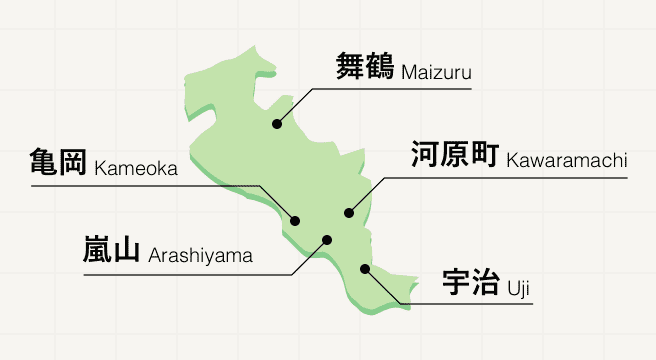Shrine Spots in Uzumasa / Hanazono Area
Area
-
-
Kyoto
-
-
Kyoto
-
-
Uzumasa / Hanazono
-
- All areas
- Around Gion
- Around Kiyomizu-Dera Temple
- Around Okazaki
- Around Ginkaku-Ji Temple
- Ichijo-ji Temple / Shugakuin
- Around Fushimi Inari
- Around Kyoto Station
- City Center
- Around Kyoto Imperial Palace
- Around Nishijin
- Around Kamigamo
- Around Kinkaku-Ji Temple
- Uzumasa / Hanazono
- Arashiyama / Sagano / Takao
- Around Mt. Hiei
- Ohara / Kurama / Kifune
- Katsura / Nishiyama
- Yamashina / Daigo
- Around Fushimi
- Around Uji
- Joyo / Yawata
- Kyotanabe / Kizugawa
- Kameoka / Nantan
- Maizuru / Miyazu
-
Uzumasa / Hanazono

Category


-
- Saiin Kasuga-jinja Shrine
-
4.050 Reviews
- Travel / Tourism
- Kyoto Kyoutoshi Ukyou-ku Sainkasugachou 61
- "A three-minute walk from Saiin Station and the ""Nishioji Shijo"" bus stop. This Shinto shrine is located north along Sai-dori Street. The shrine was started in Saiin by Emperor Junna when he had it moved here when he retired from the throne in 833. The shrine gained imperial patronage when Emperor Junna's daughter, Princess Takako, recovered from smallpox after praying at the shrine, and even today many worshippers come here. The shrine is believed to grant worshippers recovery from illness and protection from illness. Many people also come here before setting off on a trip to pray for a safe journey and safe driving. A huge cluster of wisteria known as the Rokushaku-fuji grows on the grounds and the shrine holds a wisteria blossom festival each year on April 29."
-
If you are exploring Nara and the key sights, its worth the extra effort to get to this attraction which is set in very peaceful woodland.
-
- Konoshima Nimasu Amateru Mitama Shrine
-
4.033 Reviews
- Travel / Tourism
- Kyoto Kyoutoshi Ukyou-ku Uzumasamorigahigashichou 50
- "A five-minute walk from Kaikonoyashiro Station, Uzumasa Tenjingawa Station, and the ""Kaikonoyashiro"" bus stop; and a seven-minute walk from Hanazono Station. Situated along the Taishimichi, this Shinto shrine has an auxiliary shrine dedicated to sericulture (silkworm farming) and is thus also known as the Silkworm Shrine. This area was a center of sericulture, weaving, and dyeing and this shrine was established and dedicated to sericulture and weaving by the Hata clan, a wealthy family who came to Japan from China. Even today, the shrine is still visited by people involved in the sericulture industry. At Mototasasu no Ike pond, which purportedly has miraculous healing properties, there is a three pillared torii gate, one of only a very few examples found in the country. On the day of the ox in midsummer, a water purification festival is held here."
-
地下鉄東西線の太秦天神川駅から徒歩5分ほど。 創建年不明(701年以前)。祭神は天之御中主神、大国魂神、穂々出見命、鵜茅葺不合命、瓊々杵尊。境内入口から本殿までまっすぐに参道が延び、途中に吹き放ちの拝殿がある。社殿は明治以降に再建されたもので、拝殿は木造瓦葺き、本殿と拝所は木造銅板葺き。本殿左手には神池「元糺の池」(もとただすのいけ)があるが湧水は枯れ空池となっている。その池の中には3つ鳥居を組み...
-
- Sanno Shrine
- Travel / Tourism
- Kyoto Kyoto-shi Ukyo-ku Yamanouchimiyawakicho 5
-
- Koromode shrine
- Travel / Tourism
- Kyoto Kyoutoshi Ukyou-ku Nishikyougokuhigashikoromodechou
-
- Kaikonoyashiro
- Travel / Tourism
- Kyoto Kyoto-shi Ukyo-ku Uzumasamorigahigashicho
Kyoto Areas

Its wooden tea houses, shuffling geisha, and spiritual sights have seen Kyoto hailed as the heart of traditional Japan, a world apart from ultramodern Tokyo. Despite being the Japanese capital for over a century, Kyoto escaped destruction during World War II, leaving behind a fascinating history which can be felt at every turn, from the fully gold-plated Kinkakuji Temple down to traditional customs such as geisha performances and tea ceremonies, which are still practiced to this day.
Best of Kyoto
Search by Region
-
- Hokkaido / Tohoku
- Hokkaido
- Aomori
- Iwate
- Miyagi
- Akita
- Yamagata
- Fukushima
-
- Kanto
- Ibaraki
- Tochigi
- Gunma
- Saitama
- Chiba
- Tokyo
- Kanagawa
-
- Koshinetsu / Hokuriku
- Niigata
- Toyama
- Ishikawa
- Fukui
- Yamanashi
- Nagano
-
- Tokai
- Gifu
- Shizuoka
- Aichi
- Mie
-
- Kinki
- Shiga
- Kyoto
- Osaka
- Hyogo
- Nara
- Wakayama
-
- Chugoku
- Tottori
- Shimane
- Okayama
- Hiroshima
- Yamaguchi
-
- Shikoku
- Tokushima
- Kagawa
- Ehime
- Kochi
-
- Kyushu / Okinawa
- Fukuoka
- Saga
- Nagasaki
- Kumamoto
- Oita
- Miyazaki
- Kagoshima
- Okinawa













